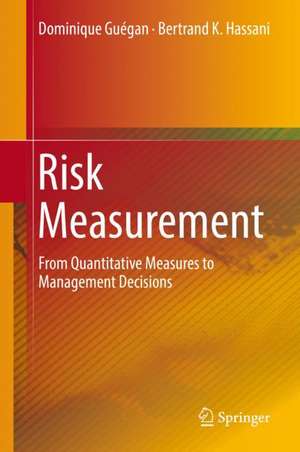Risk Measurement: From Quantitative Measures to Management Decisions
Autor Dominique Guégan, Bertrand K. Hassanien Limba Engleză Hardback – 2 apr 2019
Preț: 587.02 lei
Preț vechi: 690.62 lei
-15% Nou
Puncte Express: 881
Preț estimativ în valută:
112.33€ • 117.52$ • 93.31£
112.33€ • 117.52$ • 93.31£
Carte tipărită la comandă
Livrare economică 03-17 aprilie
Preluare comenzi: 021 569.72.76
Specificații
ISBN-13: 9783030026790
ISBN-10: 3030026795
Pagini: 273
Ilustrații: XIV, 215 p. 30 illus., 16 illus. in color.
Dimensiuni: 155 x 235 mm
Greutate: 0.5 kg
Ediția:1st ed. 2019
Editura: Springer International Publishing
Colecția Springer
Locul publicării:Cham, Switzerland
ISBN-10: 3030026795
Pagini: 273
Ilustrații: XIV, 215 p. 30 illus., 16 illus. in color.
Dimensiuni: 155 x 235 mm
Greutate: 0.5 kg
Ediția:1st ed. 2019
Editura: Springer International Publishing
Colecția Springer
Locul publicării:Cham, Switzerland
Cuprins
1 Introduction.- 2. Financial Institutions : A Regulation review through the Risk Measurement prism.- 3. The Traditional Risk measures.- 4. Univariate and Multivariate Distributions.- 5. Extensions for Risk Measures: Univariate and Multivariate Approaches.- 6. Risks Measures and Dynamics.- 7. Markov Switching modelling.
Recenzii
“The book is a useful reading for both academics and practitioners in the field of financial and actuarial management.” (Pavel Stoynov, zbMATH 1426.91004, 2020)
Notă biografică
Dominique Guégan is Professor Emeritus (Applied Mathematics and Applications of Mathematics) at the Université Paris 1 Panthéon Sorbonne.
Bertrand K. Hassani is Chief Solutions Officer at Instadeep, Honorary Reader at University College London (Computer Science) and Associate Researcher at Université Paris 1 Panthéon Sorbonne.
Bertrand K. Hassani is Chief Solutions Officer at Instadeep, Honorary Reader at University College London (Computer Science) and Associate Researcher at Université Paris 1 Panthéon Sorbonne.
Textul de pe ultima copertă
This book combines theory and practice to analyze risk measurement from different points of view. The limitations of a model depend on the framework on which it has been built as well as specific assumptions, and risk managers need to be aware of these when assessing risks. The authors investigate the impact of these limitations, propose an alternative way of thinking that challenges traditional assumptions, and also provide novel solutions. Starting with the traditional Value at Risk (VaR) model and its limitations, the book discusses concepts like the expected shortfall, the spectral measure, the use of the spectrum, and the distortion risk measures from both a univariate and a multivariate perspective.
Caracteristici
Discusses new methodologies to capture and measure risk Includes compliance and regulatory aspects of risk measurement Offers practical case studies related to risk measurement
